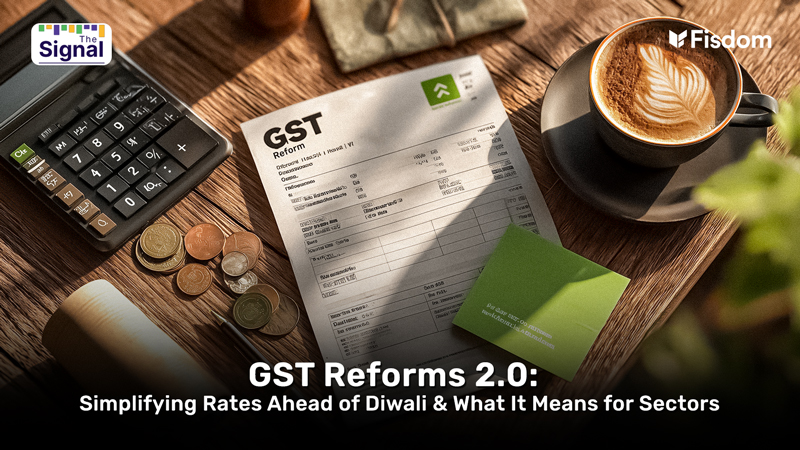
India is poised for a sweeping transformation of its Goods and Services Tax (GST) regime, with Prime Minister Narendra Modi pledging a “Diwali gift” that cuts complexity and rates by October 2025. The proposed overhaul marks the most substantial change since GST was launched in 2017—and it arrives at a crucial moment for both consumers and businesses.
The Crux of the Reform
India currently operates a four-slab GST system—5%, 12%, 18%, and 28%—with additional levies on luxury and sin goods. Under GST Reforms 2.0, this would be replaced by a two-slab framework: 5% for essentials and 18% as the standard rate. A special rate of around 40% is likely to be retained only for items like cigarettes and luxury goods. Health and life insurance premiums may even be exempted entirely, as part of the rationalisation effort.
Prime Minister Modi has tasked the GST Council to finalise these changes ahead of Diwali, with the intent of simplifying the tax structure and making essential goods and services more affordable.
What It Means for the Consumer and the Macro Economy
Consumers stand to benefit significantly. Estimates suggest retail prices across eligible categories could decline by 4–5%, easing inflation and improving spending power. The move could also trim CPI inflation by as much as 40–60 basis points and effectively inject a 0.5–0.7% GDP stimulus.
While the central government may face a revenue dip—analysts estimate a shortfall of about ₹50,000 crore—this is seen as manageable, especially if the consumption impulse drives higher volumes of GST collection. Some policymakers have flagged potential interest-rate implications over the medium term, as increased consumption could alter monetary policy dynamics.
At the same time, several states have voiced concern. They argue that lower tax rates could erode vital revenues and are calling for compensatory support from the Centre, similar to the arrangements made when GST was first rolled out.
A Sector-by-Sector Snapshot
Automobile Industry
The auto sector is likely to be one of the biggest beneficiaries. Cars, two-wheelers, and commercial vehicles currently taxed at 28% could shift to 18%. Price reductions of 7–10% are possible, potentially reviving demand in both urban and rural markets. Leading automakers such as Maruti Suzuki, Bajaj Auto, Hero MotoCorp, TVS Motors, Eicher Motors, Tata Motors, Ashok Leyland, and Mahindra & Mahindra could see stronger volumes during the festive season.
Cement & Real Estate
A transition from 28% to 18% in GST could reduce cement prices by 7–8%, or around ₹30–40 per bag. This would directly improve affordability in housing and infrastructure projects. Cement majors like Ultratech, JK Cement, and Shree Cement may see higher demand, while real estate developers stand to benefit from lower input costs, potentially improving margins by 40–50 basis points.
FMCG & Ayurveda
Packaged foods, dairy products, juices, and herbal or ayurvedic goods are expected to move from 12% to 5%. This will improve affordability for households and widen access in rural areas. Companies such as Dabur, Emami, ITC, Nestlé India, Britannia, and Patanjali Foods may witness improved volume growth, with stronger rural penetration and premium category adoption.
Consumer Durables
Products like air conditioners, televisions, refrigerators, and washing machines could shift to the 18% GST slab. This would make big-ticket appliances more affordable ahead of the festive season, potentially boosting sales for companies like Voltas, Blue Star, Amber Enterprises, Havells, and Dixon Technologies.
Apparel & Footwear
Clothing and footwear categories priced above ₹1,000, which have faced higher GST rates, may move to the lower 5% slab. This could give a significant boost to organized retail and apparel sales, helping players like Bata, Relaxo, Metro Brands, Trent, and Shoppers Stop expand volumes and gain share from unorganized competitors.
Insurance, Retail & Banking
If health and life insurance premiums are exempted from GST, the cost of coverage will decline, encouraging more households to opt for policies. This could improve insurance penetration in India over the medium term.
Meanwhile, the overall increase in disposable income due to cheaper goods and services will benefit retail, hospitality, and financial services. Banks and NBFCs such as ICICI Bank, HDFC Bank, IDFC First Bank, and Bajaj Finance could see credit growth accelerate as consumer demand strengthens. Retail companies, hotels, and tourism-related businesses may also benefit from higher discretionary spending.
The Bottom Line
GST Reforms 2.0 goes beyond a simple tax rate cut—it is a structural simplification aimed at boosting consumption and supporting long-term economic stability. For consumers, the impact will be felt in everyday savings on essentials, lower costs for automobiles and durables, and reduced household budgets. For corporates, the reforms bring opportunities for margin expansion, stronger volume growth, and better visibility in sectors tied to discretionary spending.
Implementation remains the key challenge. Timely GST refunds, smooth compliance transitions, and fiscal coordination between the Centre and states will determine how quickly the benefits flow into the economy. But if executed effectively, these reforms could mark one of India’s most significant indirect tax shifts since GST was first introduced.
As the festive season approaches, GST Reforms 2.0 has the potential to reshape consumer sentiment, drive business growth, and provide a meaningful tailwind for the economy at large
Market this week
| 18th Aug 2025 (Open) | 22nd Aug 2025 (Close) | %Change | |
| Nifty 50 | ₹ 24,938 | ₹ 24,870 | -0.3% |
| Sensex | ₹ 81,316 | ₹ 81,307 | 0.0% |
Source: BSE and NSE
- The Indian equity market remained largely flat in the week ended August 22, supported by hopes of GST rationalisation, a good monsoon, and lower oil prices.
- Profit booking emerged at higher levels ahead of the August 27 deadline for US tariffs.
- Sectorally, the BSE Auto index gained 5%, while Consumer Discretionary, Telecom, and Realty indices rose more than 3% each.
- On the downside, the BSE PSU and Power indices slipped 0.5% each.
- The pace of FII selling moderated, though they remained net sellers for the eighth straight week, offloading equities worth ₹1,559.51 crore.
- DIIs continued their strong support, marking the 18th consecutive week of net buying, with inflows of ₹10,388.23 crore.
Weekly Leaderboard
| NSE Top Gainers | NSE Top Losers | ||||
| Stock | Change (%) | Stock | Change (%) | ||
| Maruti Suzuki | ▲ | 10.9% | ITC | ▼ | -3.2% |
| Nestle India | ▲ | 6.8% | Bharat Electronics | ▼ | -2.6% |
| Hero MotoCorp | ▲ | 6.2% | Coal India | ▼ | -2.6% |
| HUL | ▲ | 6.0% | L&T | ▼ | -2.2% |
| Bajaj Auto | ▲ | 5.7% | JIO Financial | ▼ | -2.1% |
Source: BSE
Stocks that made the news this week:
Shares of paint, tyre, and oil marketing companies declined on August 22 as global crude oil prices inched higher. Brent Crude futures rose 0.3% to $67.85 per barrel, while WTI Crude gained 0.33% to $64. Rising crude raises input costs for these sectors, pressuring margins. Asian Paints, Indigo Paints, and Berger Paints slipped up to 2%, while tyre majors MRF, Apollo Tyres, JK Tyre, and Balkrishna Industries also ended lower.
Nazara Technologies extended losses after announcing that its associate firm, Moonshine Technologies, operator of PokerBaazi, has suspended real-money online gaming operations. The move was taken “as a matter of abundant caution” in line with government directives. Shares of Nazara fell nearly 4% to ₹1,158 on the development.
Meanwhile, Apollo Hospitals Enterprise witnessed a large block deal as promoter Suneetha Reddy sold a 1.3% stake worth ₹1,489 crore. The shares were offloaded at ₹7,850 apiece, with participation from prominent domestic and foreign institutional investors including Morgan Stanley, Goldman Sachs, ADIA, and several mutual funds. Despite the transaction, the stock closed almost flat at ₹7,922 on the NSE.














